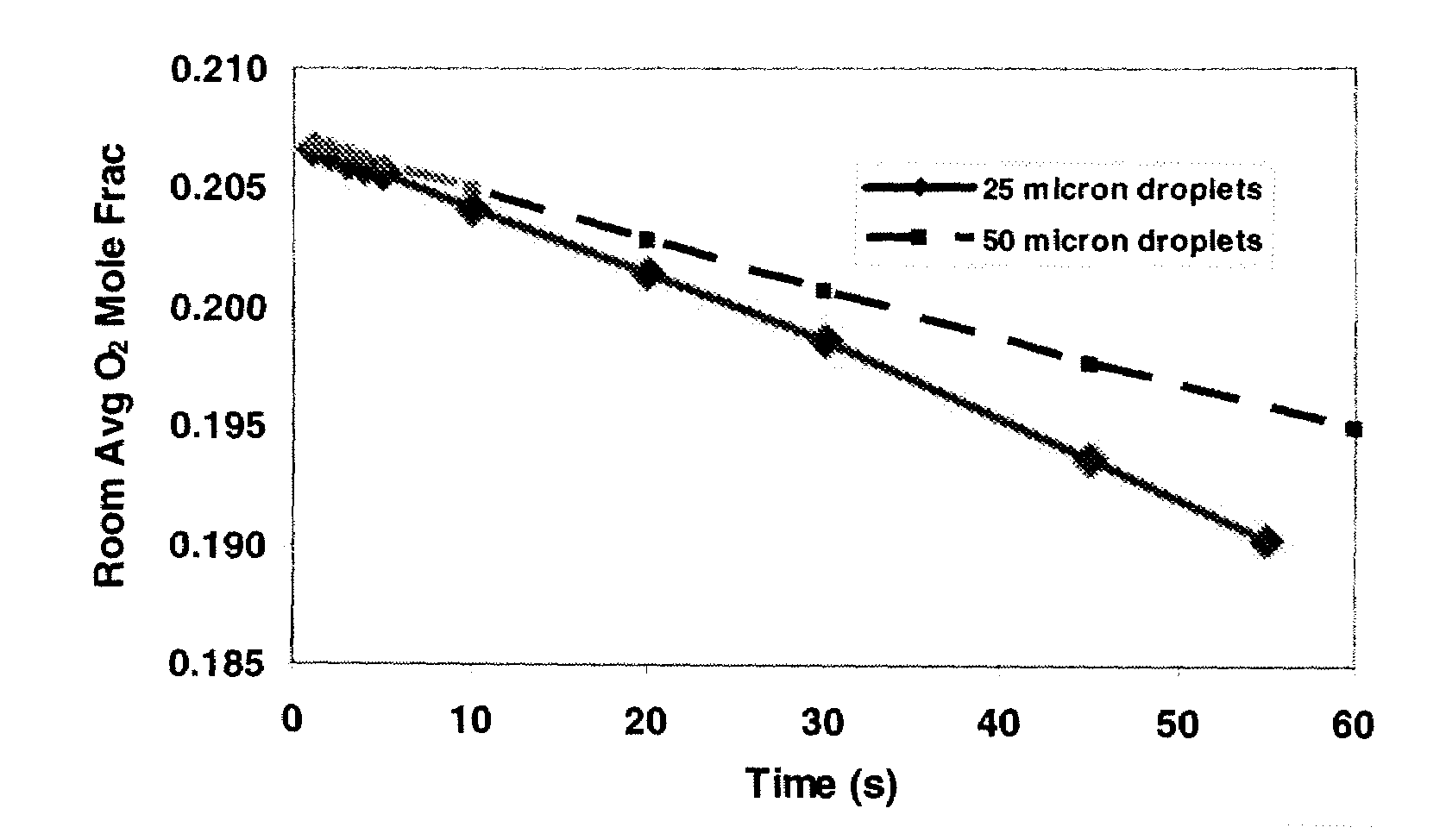Method For Fire Suppression
- Summary
- Abstract
- Description
- Claims
- Application Information
AI Technical Summary
Benefits of technology
Problems solved by technology
Method used
Image
Examples
example 1
Effect of Droplet Size on Fire Suppression
General Procedure
[0034]Fire suppression simulations were carried out based upon a flame having a width of 0.127 meters producing 50,000 BTU's / hour in a room having a dimension of 4 meters in diameter and a height of 3 meters. The simulations were carried out with a commercial general-purpose computational fluid dynamics software package called FLUENT by Fluent, Inc. Fire suppressing sprays were introduced from the ceiling in the room. Assumptions made in the simulations included an axisymmetric model, turbulent flow, oxygen consumption by the fire is insignificant; and a ceiling temperature of 355° F. is reached 76 seconds after the fire has started when no fire suppressing treatments provided. A fire suppressing medium (FSM) of water and gas at a 4.4 lb / minute was used. Droplet size was varied from 25 to 1000 microns.
[0035]The average molar concentration of oxygen as simulated in the room was determined and is shown in FIG. 1. The results s...
example 2
Effect of Droplet Size on Flame Height
[0036]The simulation of Example 1 was repeated except that flame height was measured as a function of droplet size.
[0037]FIG. 2 shows that finer water droplets reduce the flame height faster. As shown in FIG. 2, the flame height of the simulated fire was reduced by a factor 50% in less than a minute using a 25 micron mist.
[0038]It is believed the effectiveness of the small droplet size in a fire suppressing mist is a result of the increased surface area of the droplet. FIG. 3 is a view of droplet size vs. surface area. As shown in FIG. 3, finer droplets result in more total surface area.
example 3
Determination of Effect of Surfactants and Deionized Water on Droplet Size as a Function of Pressure
[0039]Several formulations for a fire suppression application were evaluated using air-atomizing and hydraulic style nozzles to determine the effects of atomizing air flow rate, liquid flow rate and composition of the liquid on the drop size and spray characteristics.
[0040]The nozzles used during testing were Spraying Systems Co. ¼ JAU-SS Automatic Air Atomizing Nozzles. The JAU style nozzle features an internal air cylinder for controlled “on-off” operation up to 180 cycles per minute. A wide variety of spray set-ups can be used with this nozzle to create a variety of flat and round spray patterns. This nozzle can also be equipped with a clean-out needle that protrudes through the liquid orifice on every cycle.
[0041]The ¼ JAU-SS nozzle provides identical spray performance to the ¼J nozzle. However, the automated features of the ¼ JAU allow for quicker testing trials. These nozzles us...
PUM
 Login to View More
Login to View More Abstract
Description
Claims
Application Information
 Login to View More
Login to View More - R&D
- Intellectual Property
- Life Sciences
- Materials
- Tech Scout
- Unparalleled Data Quality
- Higher Quality Content
- 60% Fewer Hallucinations
Browse by: Latest US Patents, China's latest patents, Technical Efficacy Thesaurus, Application Domain, Technology Topic, Popular Technical Reports.
© 2025 PatSnap. All rights reserved.Legal|Privacy policy|Modern Slavery Act Transparency Statement|Sitemap|About US| Contact US: help@patsnap.com



